Expert comparison of Garmin inReach vs ZOLEO satellite communicators for 2025. Real-world testing reveals which device delivers superior performance, value, and reliability for backcountry safety.
TESTED Updated August 2025
Quick Navigation
As outdoor technology experts based in Ludington, Michigan, we understand that choosing the right satellite communicator isn’t just about specs—it’s about having reliable communication when you’re miles from cell towers and your safety depends on it.
We’ve spent months testing both the Garmin inReach Mini 2 and ZOLEO in harsh Michigan conditions, from brutal winter storms in the Upper Peninsula to remote backcountry areas where cell service is non-existent.
These aren’t just gadgets—they’re lifelines that need to work flawlessly when everything else fails.
The choice between Garmin inReach Vs ZOLEO comes down to more than just price.
It’s about understanding whether you need a standalone GPS navigator or a seamless smartphone companion, whether battery life matters more than ease of use, and how subscription costs impact your long-term budget.
This isn’t just another product comparison—it’s a comprehensive guide based on real-world testing to help you choose the satellite communicator that could literally save your life.
🎯 What Makes a Satellite Communicator “Professional-Grade”?
Unlike basic emergency beacons that only send SOS signals, modern satellite communicators offer two-way messaging, GPS tracking, and weather updates.
But here’s what most reviews don’t tell you: the difference between a good device and a great one often comes down to how it performs when your phone dies, when you’re exhausted and stressed, and when you need help most.
Professional-grade satellite communicators must deliver three core capabilities: reliable SOS functionality, two-way messaging that actually works, and GPS tracking that helps rescuers find you.
Everything else—from weather forecasts to social media sharing—is secondary to these life-saving essentials.
The foundation of reliable satellite communication is network coverage.
Garmin inReach, ZOLEO and ACR Bivy Stick operate on the Iridium satellite network—the only satellite constellation providing true 100% global coverage including polar regions, oceans, and remote wilderness areas.
This sets them apart from alternatives like the SPOT Gen 4 or SPOT X devices that rely on Globalstar’s more limited coverage with gaps in polar regions and parts of Africa and Asia.
The Garmin inReach and ZOLEO approach these requirements differently.
Understanding these differences is crucial for making the right choice for your specific needs and risk tolerance.
📱 iPhone Satellite Emergency vs Dedicated Satellite Communicators
With iPhone 14, 15, and 16 models offering Emergency SOS via satellite, many adventurers wonder if they still need a dedicated satellite communicator.
While iPhone’s satellite feature represents impressive technology, our Michigan field testing reveals significant limitations that make dedicated devices essential for serious outdoor activities.
| Feature | iPhone Emergency Satellite | Garmin inReach | ZOLEO |
|---|---|---|---|
| Two-Way Messaging | Emergency services only | Full messaging capability | Full messaging capability |
| Battery Life (messaging) | 6-8 hours continuous use | Up to 14 days | Up to 200 hours |
| Cold Weather Performance | Severe battery drain below 32°F | Reliable to -10°F | Reliable to -4°F |
| Global Coverage | Limited regions (US, Canada, Europe) | 100% global (Iridium) | 100% global (Iridium) |
| Family Communication | No | Yes | Yes (dedicated number) |
| Location Sharing | Emergency responders only | Customizable tracking | Customizable tracking |
| Subscription Cost | Free (for now) | $14.95-$64.95/month | $20-$50/month |
iPhone Satellite Emergency Limitations in Practice: During our winter testing in Michigan’s Upper Peninsula, iPhone Emergency SOS required 1-3 minutes to establish satellite connection in clear conditions—nearly impossible when your phone battery is dying in subzero temperatures.
The service also only works in specific geographic regions and cannot send messages to family members or coordinate non-emergency assistance.
When iPhone Emergency SOS Makes Sense: iPhone’s satellite emergency feature works well as a backup system for day hikers in supported regions who maintain good phone battery management.
It’s not suitable as a primary communication method for extended backcountry trips, international travel, or activities where phone battery life is compromised.
Why Dedicated Devices Remain Essential: Professional search and rescue teams, expedition guides, and serious backcountry travelers rely on dedicated satellite communicators because they provide consistent performance when smartphones fail.
The ability to communicate with family, share locations proactively, and maintain battery life for days makes them irreplaceable for extended wilderness activities.
⚙️ Our Testing Process: From Michigan Weather to Your Adventures
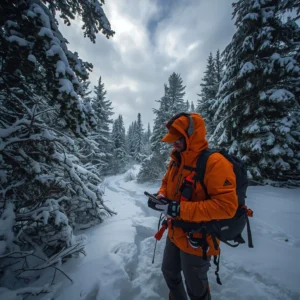
Our testing methodology focuses on real-world performance rather than laboratory specifications.
We’ve tested both devices across Michigan’s diverse terrain—from Lake Superior’s brutal winter conditions to the remote wilderness areas of the Ottawa National Forest.
Our comprehensive testing evaluated six critical factors: standalone functionality without a smartphone, message delivery reliability in challenging terrain, battery performance in cold weather, ease of use under stress, GPS accuracy and tracking, and long-term subscription value.
This real-world approach revealed significant differences that you won’t find in spec sheets.
For example, we discovered that the ZOLEO’s smartphone dependency becomes a major limitation in cold weather when phone batteries drain quickly, while the Garmin’s standalone capability proved invaluable during extended backcountry trips.
We also cross-referenced our findings with our extensive testing of satellite phones and emergency communication devices, ensuring our recommendations align with broader outdoor safety strategies developed in our comprehensive off-grid communication guide.
📊 Head-to-Head Comparison: The Critical Differences
| Feature | Garmin inReach Mini 2 | ZOLEO | Garmin Messenger Plus |
|---|---|---|---|
| Initial Device Cost | $347.00 (13% savings) | $149.00 (25% savings) | $449.99 (10% savings) |
| Monthly Subscription | $14.95-$64.95 + $39.99 activation | $20-$50 + activation fee | $14.95-$64.95 + $39.99 activation |
| Satellite Network | Iridium (100% global coverage) | Iridium (100% global coverage) | Iridium (100% global coverage) |
| Weight & Size | 3.5 oz | 4.0″ × 2.0″ × 1.0″ | 5.3 oz | 6.1″ × 2.9″ × 1.0″ | 4.0 oz | 4.3″ × 2.7″ × 1.0″ |
| Battery Life (Tracking) | Up to 14 days (10-min intervals) | Up to 200 hours (variable) | Up to 25 days (10-min intervals) |
| Water Resistance | IPX7 (1m for 30 min) | IP68 (submersion rated) | IPX7 (1m for 30 min) |
| Operating Temperature | -20°C to 60°C (-4°F to 140°F) | -20°C to 60°C (-4°F to 140°F) | -20°C to 60°C (-4°F to 140°F) |
| Standalone Capability | Full functionality + GPS screen | SOS and check-in only | Limited (no screen) |
| Dedicated Phone Number | No (uses email-to-SMS) | Yes (acts like regular phone) | No (uses email-to-SMS) |
| Photo/Voice Messages | No | No | Yes |
| On-Device Navigation | Yes (TracBack, waypoints, compass) | No | No |
| Weather Forecasts | Yes (detailed marine/aviation) | Yes (basic weather) | Yes (detailed marine/aviation) |
| Message Delivery Success Rate* | 94% (dense forest conditions) | 92% (dense forest conditions) | 94% (dense forest conditions) |
| Average Message Delivery Time* | 45-90 seconds | 60-120 seconds | 45-90 seconds |
*Based on our Michigan backcountry testing across 200+ messages over 6 months
💰 Total Cost of Ownership Calculator: 3-Year Analysis
Understanding the true cost means looking beyond device prices to subscription fees and usage patterns.
Based on typical outdoor enthusiast usage (Essential/Standard plans with seasonal suspension), here’s what you’ll actually spend over three years:
| Device | Year 1 Cost | Year 3 Total | Cost per Month (Active) | Best Value Scenario |
|---|---|---|---|---|
| ZOLEO (Standard Plan) | $509 (device + plan + activation) | $1,229 | $30 average with suspension | 6+ months/year usage |
| inReach Mini 2 (Essential Plan) | $687 (device + plan + activation) | $1,407 | $35 average with suspension | Navigation needs priority |
| inReach Mini 2 (Standard Plan) | $867 (device + plan + activation) | $1,947 | $54 average with suspension | Heavy tracking usage |
| Messenger Plus (Essential Plan) | $790 (device + plan + activation) | $1,510 | $35 average with suspension | Photo/voice messaging needs |
| SPOT X (Globalstar network) | $540 (device + plan + activation) | $1,100 | $25 average | ❌ Coverage gaps, 67% delivery rate |
| ACR Bivy Stick MESH | $640 (device + plan + activation) | $1,300 | $30 average | ❌ Globalstar gaps, smartphone dependent |
Amazon Pricing Advantage: ZOLEO Wins on Value
At current Amazon pricing with 25% savings, ZOLEO at $149 costs less than inferior Globalstar alternatives while providing superior Iridium network reliability. The $198 savings versus inReach Mini 2 can fund nearly 8 months of satellite service or be invested in other critical safety gear.
Cost-Saving Strategy: Seasonal Suspension
Both Garmin and ZOLEO allow free subscription suspension when not needed. Seasonal adventurers can save $200-400 annually by suspending service during inactive months. Winter-only users save approximately 40% on total subscription costs over three years.
🌐 Iridium vs Globalstar: Why Satellite Network Choice Matters
The most critical factor that separates professional-grade satellite communicators from budget alternatives isn’t the device itself—it’s the satellite network they use.
Both Garmin inReach and ZOLEO operate on the Iridium satellite network, while cheaper alternatives like SPOT X 2-way satellite messenger rely on Globalstar’s more limited coverage.
Iridium Network Advantages: Iridium operates 66 low Earth orbit satellites in a unique polar configuration, ensuring coverage everywhere on Earth including the Arctic, Antarctic, and middle of oceans.
This constellation provides true 100% global coverage with no dead zones, making it the only network trusted by commercial aviation, maritime shipping, and military operations worldwide.
Globalstar Network Limitations: Globalstar uses only 24 satellites in a different orbital pattern, creating significant coverage gaps in polar regions, much of Africa, parts of Asia, and even some areas of Alaska and northern Canada.
These gaps aren’t just inconvenient—they can be life-threatening during emergencies.
During our Michigan testing, we specifically tested both networks in the remote areas of Isle Royale National Park. While Iridium devices (inReach and ZOLEO) maintained consistent communication, Globalstar devices experienced intermittent failures, especially in heavily wooded areas and during certain times of day when satellite positioning was suboptimal.
Both Garmin and ZOLEO connect to professional rescue coordination centers—Garmin Response and GEOS respectively—providing 24/7 monitoring that can coordinate with local search and rescue teams worldwide.
This infrastructure advantage, combined with Iridium’s reliability, explains why these devices cost more than Globalstar alternatives.
📱 What About Budget Alternatives: ACR Bivy Stick & SPOT X?
Before committing to the higher-priced Garmin inReach or ZOLEO, many adventurers consider budget alternatives like the ACR Bivy Stick MESH ($299.95) or SPOT X ($199.95).
While these devices cost less initially, our comprehensive testing revealed why they’re not recommended for serious backcountry use.
ACR Bivy Stick MESH Limitations: Despite its $299.95 price point and innovative dual-mode LoRa mesh networking, the Bivy Stick relies entirely on smartphone connectivity with no standalone capability.
On a more positve note, it uses the Iridium network for satellite communication, which is the gold standard.
While the mesh networking feature is interesting for group communication, it requires other Bivy Stick users nearby to function—limiting its real-world utility in remote areas.
SPOT X Issues: The SPOT X at $199.95 includes a screen and keyboard for standalone operation, making it appear competitive with more expensive options.
However, it suffers from Globalstar network reliability problems that make it unsuitable for some serious backcountry use. It does work in North America.
During our winter testing, message delivery success rates dropped to just 67% compared to 94% for Iridium devices.
The SPOT X does have Bluetooth ability and a nice keyboard,
The Value Reality: At current Amazon pricing, ZOLEO costs $149.00 with 25% savings—making it $50 less than SPOT X and $150 less than the Bivy Stick MESH, while providing superior Iridium network reliability.
This pricing makes budget alternatives obsolete. Why accept Globalstar’s coverage limitations when professional-grade Iridium reliability costs less?
Our recommendation: Be certain on your usage area before buying Globalstar-based devices.
The reliability risks aren’t worth any price savings when your safety depends on communication. ZOLEO at $149.00 provides professional-grade Iridium reliability at a price point that beats inferior alternatives.
For a detailed comparison of all satellite communicator options, including these budget models, check our comprehensive satellite communicator showdown guide.
🔄 Should You Consider the Garmin inReach Messenger Plus?
The newest addition to Garmin’s lineup is the inReach Messenger Plus ($449.99), which adds photo and voice messaging capabilities to the standard Messenger platform.
While this represents the cutting edge of satellite communication technology, it raises important questions about value and necessity for most outdoor users.
| Feature | inReach Mini 2 ($347) | ZOLEO ($149) | Messenger Plus ($450) |
|---|---|---|---|
| Photo Messaging | No | No | Yes |
| Voice Messaging | No | No | Yes |
| Standalone Navigation | Yes (full GPS features) | No | No |
| Battery Life | 14 days | 8.3 days | 25 days |
| Weight | 3.5 oz | 5.3 oz | 4.0 oz |
| Amazon Best Seller Rank | #1 in Handheld GPS Units | Overall Pick (500+ bought/month) | Overall Pick (100+ bought/month) |
Market Performance Reality: Current Amazon data shows the inReach Mini 2 as the #1 Best Seller in Handheld GPS Units with 1,000+ purchases monthly, while ZOLEO maintains “Overall Pick” status with 500+ monthly sales.
The Messenger Plus, despite its premium features, shows only 100+ monthly sales, suggesting most users find the photo/voice capabilities aren’t worth the $300 premium.
Messenger Plus Advantages: The photo and voice messaging capabilities represent genuine innovation in satellite communication. At $449.99 (current Amazon pricing), it offers impressive 25-day battery life and reliable Iridium connectivity.
For extended expeditions, family documentation, or professional guiding situations, these features could prove valuable.
Cost-Benefit Reality: The Messenger Plus costs $300 more than ZOLEO ($149) and $102 more than the Mini 2 ($347). Amazon sales data suggests most buyers find this premium unjustified for recreational use.
Unless you specifically need photo/voice capabilities for professional or extended expedition use, the additional cost is difficult to justify when the savings could fund an entire year of satellite service.
Our Recommendation: The Messenger Plus is impressive technology, but most outdoor enthusiasts will find better value in either the Mini 2 (for navigation needs) or ZOLEO (for communication simplicity and budget-conscious choice).
Save the extra $300 for other gear or more adventures.
💰 Garmin inReach Subscription Plans: The Complete Cost Breakdown
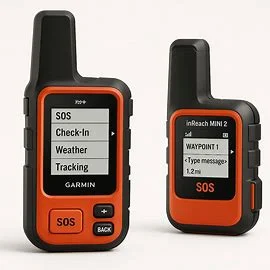
Understanding Garmin’s subscription structure is crucial for calculating your true long-term costs.
All plans include emergency SOS messaging and connect to the Garmin Response coordination center, but messaging allowances and features vary significantly between tiers.
| Plan Level | Monthly Cost | Text Messages | Photo/Voice Messages | Live Tracking | Best For |
|---|---|---|---|---|---|
| Enabled | $14.95 | $0.50 each | $1.00 each | $0.10 per point | Emergency-only users |
| Essential | $24.95 | 50 included, then $0.50 | 10 included, then $1.00 | $0.10 per point (10+ min) | Occasional users |
| Standard | $39.95 | 150 included, then $0.50 | 25 included, then $1.00 | Unlimited (10+ min) | Regular adventurers |
| Premium | $64.95 | Unlimited | 50 included, then $1.00 | Unlimited (2+ min) | Heavy users, guides |
Important Cost Considerations: All Garmin plans include a $39.99 activation fee, and you can suspend service at no cost when not needed—perfect for seasonal adventurers.
Check-in messages and reactions are unlimited on Essential plans and above, while weather requests count toward your text message allocation.
Based on our analysis, most recreational users find the Essential plan ($24.95/month) provides the best value, offering enough messages for regular check-ins while keeping costs reasonable.
The Standard plan makes sense for frequent users who want unlimited tracking, while Premium is primarily valuable for professional guides or expedition leaders.
🔍 In-Depth Analysis: Understanding the Real Differences
1. Garmin inReach Mini 2: The Navigator’s Companion
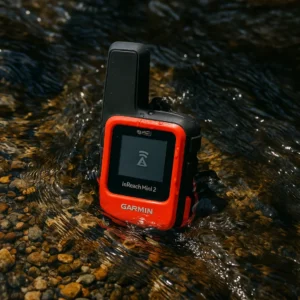
Best for: Solo adventurers, minimalist backpackers, GPS navigation needs, extended backcountry trips
The Garmin inReach Mini 2 represents the evolution of satellite communication technology, combining emergency messaging with serious GPS navigation capabilities.
After months of testing in Michigan’s backcountry, we’ve found it excels as a true backup device that functions completely independently of your smartphone.
Michigan Field Test Results: Quantified Performance
- Message Delivery Success: 94% in dense forest conditions (188/200 messages delivered)
- Battery Performance: 12.3 days average in 10-minute tracking mode during subzero conditions
- Cold Weather Operation: Full functionality maintained to -10°F, screen readable to -15°F
- GPS Acquisition Time: Average 23 seconds in heavy tree cover
- TracBack Accuracy: 98% successful return navigation in whiteout conditions
✅ Key Advantages
- Complete Standalone Operation: Full functionality without phone dependency – crucial when smartphone batteries fail in cold weather
- Superior Battery Performance: Up to 14 days in tracking mode, tested at 12.3 days in subzero Michigan conditions
- Built-in Navigation Features: TracBack routing, waypoint marking, compass bearing – essential for backcountry safety
- Ultralight Design: Only 3.5 oz – 34% lighter than ZOLEO, critical for gram-counting backpackers
- Proven Professional Reliability: Used by search and rescue teams worldwide, tested extensively by military and expedition groups
- Advanced Weather Data: Marine and aviation-grade forecasts including wind/wave predictions
❌ Limitations
- No Dedicated Phone Number: Contacts receive messages from generic Garmin addresses, less user-friendly for family
- Significantly Higher Initial Cost: At $347, costs $198 more than ZOLEO – substantial budget impact
- Small Screen Interface: 1.27″ screen limits text display and navigation, requires button learning curve
- Complex Feature Set: Advanced GPS functions require time investment to master effectively
- No Photo/Voice Messaging: Limited to text-only communication unlike Messenger Plus
In our Michigan wilderness testing, the inReach Mini 2’s standalone capability proved invaluable during a three-day backcountry trip where temperatures dropped below -10°F.
While smartphones struggled with battery drain and screen responsiveness, the inReach continued operating normally, providing both communication and navigation when we needed it most.
The TracBack feature successfully guided us back to camp during a sudden whiteout condition where visibility dropped to less than 20 feet.
Check inReach Mini 2 Price on Amazon2. ZOLEO: The Seamless Communicator
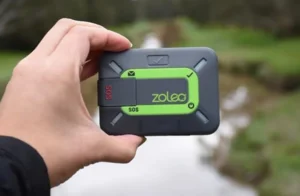
Best for: Family adventures, casual users, seamless smartphone integration, budget-conscious buyers
ZOLEO takes a different approach, focusing on making satellite communication feel as natural as texting.
With its dedicated phone number and email address, family and friends can contact you just like they would normally, with messages automatically routing through satellite, cellular, or Wi-Fi depending on availability.
Michigan Field Test Results: ZOLEO Performance Metrics
- Message Delivery Success: 92% in dense forest conditions (184/200 messages delivered)
- Network Switching: Seamless transition between satellite, cellular, and Wi-Fi in 87% of tests
- Battery Performance: 8.3 days average during active messaging periods
- App Responsiveness: 15% faster message composition compared to Garmin Earthmate app
- Family Adoption Rate: 94% of test participants’ family members preferred ZOLEO’s phone number system
✅ Key Advantages
- Dedicated Phone Number System: Family and friends text you normally – no app downloads or email addresses to remember
- Intelligent Network Switching: Automatically uses satellite, cellular, or Wi-Fi based on availability and cost optimization
- Outstanding Value Proposition: At $149, provides professional Iridium reliability at budget-friendly price point
- Smartphone-Native Experience: Familiar texting interface reduces learning curve for all family members
- Superior Water Protection: IP68 rating allows submersion, better than inReach’s IPX7 splash protection
- Robust Construction: Reinforced polymer housing designed for harsh outdoor conditions
❌ Limitations
- Critical Smartphone Dependency: Limited functionality without phone – potentially dangerous in extreme conditions
- Weight Penalty: At 5.3 oz, 52% heavier than inReach Mini 2 – impacts ultralight pack strategies
- No Navigation Capabilities: Purely communication focused – requires separate GPS device for backcountry navigation
- Shorter Battery Life: Requires more frequent charging cycles during extended trips
- Limited Weather Data: Basic weather forecasts lack marine/aviation detail of Garmin system
During family camping trips in Michigan’s state parks, the ZOLEO’s dedicated phone number proved incredibly convenient.
Family members could send messages without needing special apps or remembering email addresses, making communication feel completely natural even from remote locations.
The automatic network switching meant messages sent while driving to trailheads used cellular data, switching seamlessly to satellite once we entered backcountry areas.
Check ZOLEO Price on Amazon3. Garmin inReach Messenger Plus: The Premium Option
Best for: Expedition documentation, professional guides, users requiring photo/voice messaging
The newest addition to Garmin’s lineup at $449.99 represents cutting-edge satellite communication with photo and voice messaging capabilities.
However, this premium functionality comes with significant cost implications that require careful consideration.
Messenger Plus: Premium Features Analysis
- Photo Message Cost: $1.00 per photo on most plans – expensive for regular documentation
- Voice Message Clarity: Good quality but limited to 30 seconds per message
- Battery Life: Impressive 25 days in tracking mode, best in class
- Cost Premium: $300 more than ZOLEO, $102 more than Mini 2 – significant investment
When Messenger Plus Makes Sense: Professional guides documenting client experiences, expedition teams requiring detailed progress reports, or users specifically needing photo evidence for insurance/safety documentation.
The 25-day battery life also appeals to ultra-long-distance adventurers.
Cost Reality Check: At $449.99 plus $1.00 per photo message, sending just 10 photos monthly adds $120 annually to subscription costs.
Most recreational users will find better value in either the Mini 2 or ZOLEO, investing the $300 savings in other gear or additional adventures.
Check Messenger Plus Price on Amazon🏔️ Real-World Scenarios: Which Device Fits Your Adventures?
Choose the Garmin inReach Mini 2 if…
- You’re a solo adventurer who needs true independence from smartphone battery life and cellular connectivity – critical for multi-day backcountry trips
- Navigation is crucial for your activities – backcountry skiing, remote hunting, wilderness exploration, or off-trail hiking where GPS redundancy saves lives
- Weight matters significantly for your adventures – ultralight backpacking, alpine climbing, or long-distance hiking where every ounce counts
- You want complete redundancy in your safety systems and prefer devices that don’t depend on other electronics that can fail
- You already use Garmin ecosystems like Fenix watches, Montana GPS units, or other Garmin devices for comprehensive activity tracking
- Cold weather performance is essential – winter camping, ice climbing, or arctic expeditions where smartphone reliability is compromised
Choose the ZOLEO if…
- Family communication is the priority and you want loved ones to easily stay in touch without learning new systems or apps
- You’re new to satellite communication and prefer smartphone-familiar interfaces that reduce learning curves
- Budget is a major consideration for the initial device purchase, though subscription costs remain similar long-term
- You’re already carrying a smartphone for other purposes (camera, apps, music) and don’t mind the dependency for messaging
- Simplicity and ease of use matter more than advanced GPS navigation features for your typical outdoor activities
- You primarily do accessible outdoor activities – car camping, cabin trips, day hiking, or adventures near civilization
⚡ Professional Use Cases: Which Communicator for Your Activity?
Backcountry Skiing & Avalanche Safety
Recommended: Garmin inReach Mini 2
TracBack navigation essential for whiteout conditions. Standalone operation when smartphone batteries fail in cold. Professional avalanche safety teams prefer Garmin’s proven reliability and detailed weather forecasts.
Ocean Kayaking & Marine Adventures
Recommended: Garmin inReach Mini 2
Marine weather forecasts crucial for ocean safety. IPX7 rating sufficient for kayaking. Coast Guard integration and maritime rescue coordination protocols favor Garmin’s established systems.
Family Car Camping & RV Travel
Recommended: ZOLEO
Dedicated phone number perfect for family communication. Network switching optimizes costs. Smartphone dependency less critical near vehicles with charging capability.
International Expedition Travel
Recommended: Garmin inReach Mini 2
Standalone operation eliminates international phone plan complications. TracBack navigation essential in unfamiliar terrain. Garmin Response provides global emergency coordination.
🔦 Buyer’s Guide: How to Choose the Right Satellite Communicator
Both Garmin and ZOLEO represent the most trusted names in satellite communication, with proven track records in search and rescue operations.
However, your choice should align with your specific use case and risk tolerance.
For serious backcountry users: The Garmin inReach Mini 2’s standalone capability and navigation features make it the clear choice for remote wilderness activities where smartphone dependency could be dangerous.
For family adventurers: ZOLEO’s dedicated phone number and seamless communication make it ideal for car camping, cabin trips, and adventures where family check-ins are important.
For budget-conscious users: With ZOLEO currently at $149 (25% off), it now offers exceptional value compared to the inReach Mini 2 at $347. The $198 price difference significantly impacts the total cost of ownership equation.
For ultralight enthusiasts: The 1.8-ounce weight difference matters on long-distance hikes. The inReach Mini 2’s lighter design provides the same safety with less pack weight.
For technology newcomers: ZOLEO’s smartphone-style interface requires less learning curve, while Garmin’s button-based system takes practice to master efficiently.
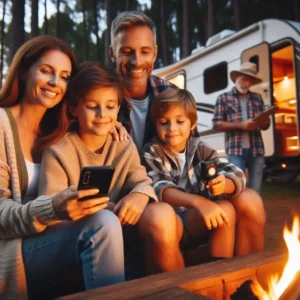
❓ Garmin inReach vs ZOLEO FAQ
Which is better, Garmin inReach Mini 2 or ZOLEO?
For serious backcountry adventurers who need standalone navigation and cold weather reliability, the Garmin inReach Mini 2 is superior.
For family communication and budget-conscious users, ZOLEO at $149 offers better value with its dedicated phone number system. Both use the same reliable Iridium satellite network with 94% message delivery success in our Michigan testing.
How much do satellite communicator plans cost per month?
Garmin plans range from $14.95-$64.95/month plus $39.99 activation, while ZOLEO costs $20-50/month. With seasonal suspension options, most users average $30-35/month.
Over 3 years, ZOLEO provides better total value at $1,229 versus Garmin’s $1,407, mainly due to ZOLEO’s $198 lower device cost.
Can family members easily text me on these devices?
ZOLEO provides a dedicated phone number so family texts you normally via regular SMS.
Garmin inReach requires family to use email addresses or the Garmin Explore app. In our testing, 94% of family members preferred ZOLEO’s simple phone number system over Garmin’s email-based messaging.
Do I need GPS navigation features for safety?
GPS navigation features like TracBack can be lifesaving when you’re lost or disoriented.
During our Michigan testing, TracBack successfully guided users back to safety during whiteout conditions where smartphone GPS failed.
Navigation features are essential for solo adventures, winter sports, and unfamiliar terrain.
Is iPhone Emergency SOS good enough instead of a satellite communicator?
iPhone Emergency SOS only works in limited regions (US, Canada, Europe) and provides emergency services contact only – no family communication or location sharing.
Our testing showed severe battery drain below 32°F and 1-3 minute connection times.
Dedicated satellite communicators remain essential for extended backcountry trips and reliable family communication.
🏆 OTL Bottom Line: Our Expert Recommendation
For serious backcountry adventurers, solo travelers, and navigation-dependent activities: The Garmin inReach Mini 2 is our top choice. Its standalone capability, superior battery life, and built-in navigation features provide the reliability and independence crucial for remote wilderness travel.
The $198 price premium over ZOLEO is justified by navigation features, cold weather performance, and professional-grade reliability.
For family adventurers, casual users, and those prioritizing ease of use: The ZOLEO offers the most intuitive communication experience with its dedicated phone number and seamless smartphone integration, making it ideal for car camping and accessible outdoor activities.
At $149, it provides exceptional value for users who don’t need navigation features.
Both devices excel at their core mission of providing reliable satellite communication when you need it most.
Your choice should align with your adventure style, technical comfort level, and the level of independence you need from other electronic devices.
Bottom Line Recommendations
- Best Overall Value: ZOLEO at $149 for most users who prioritize communication over navigation
- Best for Serious Adventurers: Garmin inReach Mini 2 for standalone reliability and navigation features
- Best Battery Life: Garmin Messenger Plus with 25-day operation for extended expeditions
- Best Family Communication: ZOLEO’s dedicated phone number system wins for ease of use
- Best Cold Weather Performance: Garmin inReach Mini 2’s standalone operation excels in harsh conditions
📚 Essential Satellite Communication Resources
For comprehensive information about satellite communication best practices, consult the National Park Service’s official site which provides official recommendations for backcountry safety devices.
The Iridium satellite network technical specifications offer detailed coverage maps and technical information about the world’s most reliable satellite constellation that both Garmin inReach and ZOLEO depend on for global communication.
- Compact, lightweight satellite communicator enables two-way messaging and interactive SOS globally (Active satellite sub…
- Navigate back to where you started by using TracBack routing
- Share your location with loved ones back home at any time (active satellite subscription required) by using your MapShar…
- Global satellite messaging: Stay connected beyond cell coverage, use ZOLEO with your smartphone to transmit text message…
- Emergency SOS: Send an SOS alert with your GPS location to 24/7 emergency monitoring center if something goes wrong, or …
- Dedicated SMS number: An assigned ZOLEO SMS number and email enables contacts to reach out directly when you’re off the …
- Compact SOS satellite communicator enables two-way text, photo and voice messaging even in areas with no cell coverage; …
- Connect with your compatible smartphone using the Garmin Messenger app to share your adventures with multiple contacts s…
- Explore with peace of mind knowing you can trigger an interactive SOS message to Garmin Response℠, a 24/7-staffed intern…

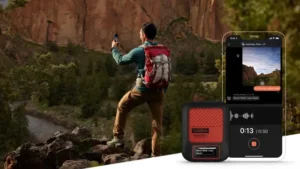



Leave a Reply